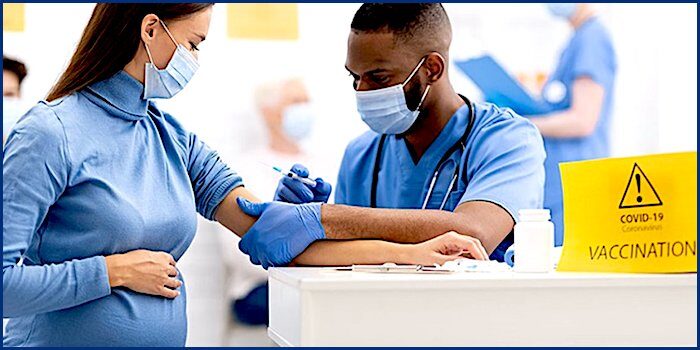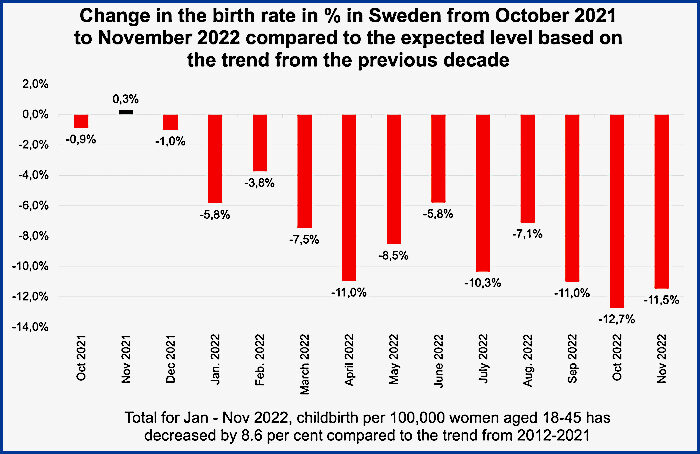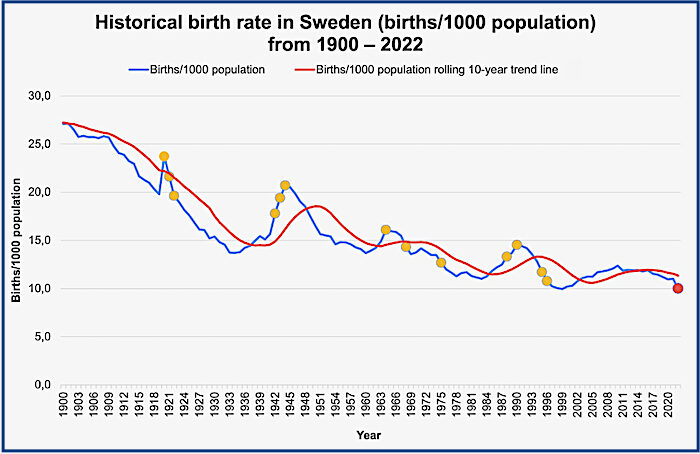To a critical ear, the silence is as deafening as it is worrying. After 11 months of official reports of a sustained fall in the birth rate, the Swedish mainstream media have reacted. However, news reports omit any reference to a possible involvement of the elephant in the room: mRNA vaccines. So, what is the evidence that we should all have an opportunity to consider?
The number of children born in Sweden has decreased by an average of 8.6% over the period from January to November 2022. The largest percentage decreases occurred over the most recent three months of reporting (September-November 2022). Over this period, 11.7% fewer children were born in Sweden to women aged 18 to 45 years, based on the figure expected from regression analysis of data from the previous 10 years.
Although data are released monthly, comment from official sources is as absent as investigative reporting from the mainstream media. A German Government working paper has noted the correlation between the drop in fertility and birth rate in both Sweden and Germany and the COVID-19 vaccine rollout. However, the paper blamed behaviour change and drew no link with the exposure of women of childbearing age to novel mRNA vaccines.
Data represented in the bar chart above are based on data from Statistics Sweden and using the number of births per calendar month per 100,000 women aged 18 to 45 years from October 2011 to November 2022, to calculate expected and observed figures. Births per month were divided by the number of women in the population on December 31st of the preceding year, expressed as a percentage.
Swedish birth rates have followed a declining trend over the last century. Exceptional negative or positive changes (plus or minus 6% over the birth rate from the preceding year) have occurred, for example following the significant peak in the 1920s and after baby booms in the 1940s, 1960s and 1990s. Except for 1922, however, there has never been such a sharp decline in birth rate over a single year as occurred in 2022.
In previous cycles of birth rate boom and bust, a notable peak has always preceded a notable decline - until now. The drop in 2022 has been preceded by 20 years of relatively stable birth rates. Whatever the explanation, there is little hope that December's data will prevent this ominous record from descending into the history books. The question that needs to be addressed, why is 2022 an outlier?
A similar pattern was not observed after the H1N1 swine flu epidemic in 2009, where about 60% of the Swedish population received the newly developed protein-based vaccine Pandemrix. The exposure of most women of childbearing age (18-45 years) to experimental COVID-19 mRNA vaccination started in May 2021, when rolled out for persons under 65 years without a risk factor.
On average, 4.6% of all births in Sweden are premature (under 37 weeks or 8.3 months of pregnancy from 2016-2021). Hence, an effect on birth rate due to mRNA vaccines would be expected from January 2022; the observed drop coincides unerringly with a possible side effect of COVID-19 mRNA vaccines.
If a stark correlation with an atypical decline in birth rate was the only signal, it should warrant an immediate halt to mRNA vaccination. However, both Pfizer and the regulators, the European Medicines Agency (EMA) in the EU, the Food and Drug Administration (FDA) in the U.S., and the Medicines and Healthcare products Regulatory Agency (MHRA) in the U.K., amongst other national agencies, were aware that mRNA vaccines could lead to effects on fertility. So how did the regulators miss this signal and even more significantly, how did the regulators authorise these products without appropriate safety testing?
Pfizer's application to the Japanese Patent Office in 2020 showed that intramuscular injection of modified mRNA with the same lipid nanoparticle carrier formulation as their COVID-19 candidate, dispersed widely through the body and away from the site of injection. The mRNA accumulated and was expressed in organs, including the ovaries of female rats.
This mRNA distribution and expression profile far exceeds that expected of a typical protein-based vaccine. Despite this, the EMA classified Pfizer/BioNTech's mRNA product BNT162B2 as a "vaccine against an infectious agent". Under regulatory legislation enacted in 2009, this enabled Pfizer/BioNTech to circumvent the more stringent regulatory framework of a Gene or Advanced Medical Therapy Product (GTMP/ATMP), which one may argue should have applied to all mRNA, DNA or viral vector vaccines expressing an intact, membrane-anchored spike protein, for which the full repertoire of biological functions is not understood.
Moreover, the EMA never publicly considered these products via its Committee on Advanced Therapies (CAT), which would normally deliberate over GTMP/ATMP status.
Reduced fertility due to negative effects on sperm may also contribute to the observed drop in birth rate. A study of sperm donors in Israel showed that the number and motility of sperm were significantly reduced five months after receiving Pfizer's mRNA vaccine. The effect of further booster doses has not been reported on either male or female fertility.
It is unknown if or how mRNA vaccination is connected to the decline in birth rates seen since 2021, not just in Sweden but throughout the world. It is equally unknown what the long-term safety effects of mRNA vaccines are - these are only now being tested on a population. Correlation does not prove causation. However, never in modern history has such a synchronised decline in birth rate been seen across the developed world, precisely aligned with the massive roll out of a new and experimental medical treatment.
About the Author:
Sven Román MD is a child and adolescent psychiatrist and one of the founders of Läkaruppropet ('Physicians' Appeal'). Jonathan Gilthorpe PhD is a cell and developmental biologist and has been a member of Läkaruppropet since 2021.






fauci cok sucker, gates lapdog and all complicit,
all hell bound
sucks to be you..